Demand for a learning environment that caters to children with special needs has allowed a learning centre to expand into a full-fledged private international school.
The Winstedt School (TWS), which used to be in Winstedt Road, moved to larger premises in Upper Boon Keng Road earlier this year.
From just three students in 2008, it now has 100 students aged five to 15. Its new location will allow it to take up to 400 students, as well as offer facilities such as a woodworking studio, running track and a sound and lighting studio, among other things.
Before it found the new space, it had to turn away students in recent years due to space constraints.
TWS has a mix of local and international students, including Australians, Russians and Portuguese.
Singaporeans who wish to attend international schools must obtain approval from the Ministry of Education (MOE).
Some 2.1 per cent of students in Singapore have a disability, including learning disabilities. Worldwide, that percentage can be up to 10 per cent.
While the usual subjects, such as geography, history and science, are taught, the differentiating element is that TWS has therapists as part of the regular school staff. They include four occupational therapists, two speech and language therapists, and an art and play therapist.
Therapy is scheduled into class timetables, and students who need additional attention can sign up for individual sessions outside of school hours, for an extra fee.
The occupational therapists help students learn to perform various activities independently, such as organising their belongings or to use proper penmanship while writing.
The speech and language therapists focus on helping students to communicate effectively, while the art and play therapist helps the students to express any anxieties through creative means.
Furthermore, a school counsellor is on hand for both formal and casual appointments, to speak about anything from anxiety about homework to issues students have with their friends.
Ms Shamini Ras Ramachandran, the counsellor, said that her charges eventually learn to find their own resolutions to conflicts, instead of lashing out in frustration.
She added: "I think what's often overlooked is that with learning difficulties come secondary feelings of lower self-esteem and anxiety."
The school also structures its curriculum to benefit students.
For instance, students take modules that cater to their ability level. So, a student could take a basic module in a language, but an advanced one in maths.
These enhancements add to the cost for an education here.
School fees cost some $44,000 to $47,000 per academic year - on a par with other international schools here - and include fees for technology and support services.
Twins Kolbe and William Tan, both 12, who previously attended another international school, have flourished under the TWS way.
"The school's more focused on the students and the curriculum is based on how students think," William said. "If you need help, you get help."
Kolbe said: "Each class has a different teaching method, and each method is chosen based on what's best for the students."



